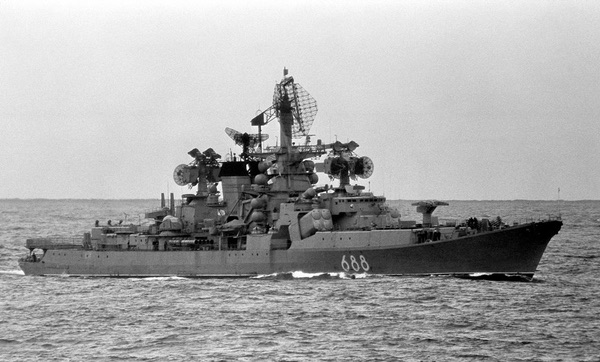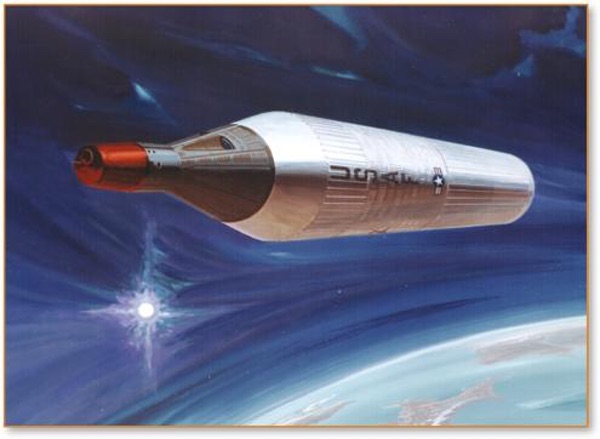Blacker than blue: the US Navy and the Manned Orbiting Laboratoryby Dwayne A. Day
|
| Navy officials would, over the next several years, come to regret their involvement. |
In early 1964, as MOL was first being defined, an Air Force officer, whose name remains unknown, warned that it was becoming an operational reconnaissance platform when it should be a laboratory. (See “Doomed from the start: The Manned Orbiting Laboratory and the search for a military role for astronauts,” The Space Review, June 17, 2019.) A laboratory, the officer argued, could take advantage of an astronauts’ ability to think, reason, and adapt, and explore the military potential for space. Reducing astronauts to the role of taking photographs and adjusting a camera was not using them to their fullest potential. But the US Navy decided to take advantage of the laboratory nature of the program, not realizing that at least some in the Air Force already knew that was a sham. Navy officials would, over the next several years, come to regret their involvement.
 Soviet Kresta II class cruiser during the Cold War. Starting in the 1960s, the Soviet Navy began venturing farther from its shores, operating in the open ocean, which made it more difficult for the US Navy to track its ships. In response, the US Navy sought to develop space systems, such as satellite-based radar, to detect large ships in the open ocean. (credit: US Navy) |
Looking for ships—from orbit
The Navy had an experiment to test: a space-based radar to perform ocean surveillance detecting ships at sea. Starting in 1962 the Navy conducted “extensive preliminary research and analytic efforts towards selecting the sensor and system best suited for, and with greatest expectation of, supporting requirements for world-wide ocean surveillance,” wrote Under Secretary of the Navy Charles F. Baird in a recently-declassified—and blistering—October 1968 memo.
“A low-resolution, detection-only radar was selected to provide an active all-weather system and the wide swaths essential for frequent, repetitive coverage of the oceans with a minimum number of satellites,” Baird continued. “Additionally, this sensor did not present the power, data handling and other development problems of more sophisticated radars.”
The Navy’s plan was to fly the sensor on the Manned Orbiting Laboratory where it could be operated by the astronauts. But in September 1966, the sensor was “canceled from the MOL program.” As Baird noted, this was only the start of the Navy’s problems.
In October 1966, due to a policy decision made by the Department of Defense’s Deputy Director for Research and Engineering, the responsibility for the radar sensor was assigned to the National Reconnaissance Office (NRO), presumably to fly on an unmanned satellite once it was ready. The Navy made its material available to the NRO, and in March 1967 suggested that one or more naval officers should be assigned to work within the NRO on the radar sensor. According to Baird, the NRO was given responsibility for a detection-only radar which would collect the location of “blob types” of information—not sufficient information to actually identify ship types on the ocean. But by May, the Navy had still not received a response from the NRO. By summer 1967, having not received any indication that the NRO was doing anything about the Navy’s ocean surveillance radar, the Navy began its own development and test of a detection radar system.
| There’s a probably apocryphal story about how Air Force General Curtis LeMay once corrected a young officer by saying “The Soviet Union is our adversary—our enemy is the Navy.” |
The Navy was also a formal participant in the NRO. The Naval Research Laboratory (NRL), located in Washington, DC, had a small office that was officially part of the NRO and designated “Program C” (Program A was the Air Force Office, located in Los Angeles and responsible for MOL, and Program B was the CIA office, located at CIA Headquarters outside of Washington.) Program C had played an important role in the development of signals intelligence satellites for the NRO starting soon after Sputnik. The NRL was almost certainly responsible for developing the Navy’s radar sensor, although Baird did not say so.
There’s a probably apocryphal story about how Air Force General Curtis LeMay once corrected a young officer by saying “The Soviet Union is our adversary—our enemy is the Navy.” The two services viewed each other with distrust, and Baird clearly saw little difference between the NRO and the Air Force, especially since the NRO was technically located within the Office of the Secretary of the Air Force and was staffed by many Air Force officers.
According to Baird, by July 1968 the radar sensor development program was achieving success, and the Navy requested a “space program designator” from the Air Force to identify the effort. Once this was granted, Baird noted, it gave the Secretary of the Air Force the ability to cancel the Navy project.
Image forming vs. Earth sensing
Baird was prompted to write his memo because of an ongoing policy dispute over which part of the military should be responsible for “Earth sensing sensors” in space. In Baird’s view, it should most certainly not be the NRO or the United States Air Force. Baird noted that an earlier policy directive stated that “all DoD needs for study, developmental, test or use of satellite image forming Earth sensors fall within the scope of the National Reconnaissance Program,” the name for the overall activities of the NRO. In summer 1968, a new directive deleted the term “image forming” leaving only “Earth sensing,” which was even broader, since any satellite in Earth orbit at the very least sensed the Earth’s gravity. Even geodetic satellites, which mapped the Earth’s shape and were necessary for Navy navigation purposes, could now fall under this definition. The Navy’s radar sensor, which the service had rescued after it was deleted from MOL and the NRO then ignored it, was now clearly at risk by the new policy.
Baird complained that having the NRO involved in “Earth sensing” projects performed by the other military services severely hindered them. The NRO imposed security restrictions that inhibited the projects from sharing information even within their service—and the Navy might not even be informed if the NRO was spending any money on a project at all. But the problems went beyond that, because the NRO could take over and then kill projects important to the other military services. That had happened with the Navy’s ship-detecting radar on MOL.
“The NRO, as previously documented, is also assigned the responsibility of developing this space system in response to Navy requirements. In the ensuing two years, they also have accomplished nothing,” Baird wrote, barely concealing his anger.
| In early 1964, the unnamed Air Force officer in the MOL program had warned that this would happen: “operational” missions always pushed out research and development missions. He could have added that Air Force missions would probably push out Navy missions as well. |
“Thus the threat of termination remains a constant threat to all Navy personnel who are participating in this program, and termination will be their reward for hard work and success, rather than for failure. When the development effort becomes successful, the program will be transferred to the Air Force or to the NRO, not because they have any stake in its success, or because it supports their missions, or because they have participated in the development or have special competence; but the transfer will take place solely because it is in accordance with applicable current directives. This procedure, the direct result of current directives, seems far removed from the objective of a strong, effective, all-service participating military space effort.”
Although the specific reasons that the Navy radar was deleted from MOL in September 1966 are not stated in Baird’s memo, the most likely reason was that NRO wanted MOL to primarily be a high-resolution reconnaissance platform, and anything that was not part of that mission was getting in the way. Indeed, in early 1964, the unnamed Air Force officer in the MOL program had warned that this would happen: “operational” missions always pushed out research and development missions. He could have added that Air Force missions would probably push out Navy missions as well, because they would be more favored by Air Force officers in the NRO.
Baird was right to be concerned about the NRO’s responsibility for the Navy sensor. Although space radar remains a mostly classified topic today, there are no indications that the Navy got to fly its “blob detection” radar in the next few years. By the latter 1960s the Navy was using signals intelligence satellites to detect vessels at sea, which only worked if they emitted signals that could be detected. By the early 1970s, the US Navy was considering a program known as Clipper Bow (i.e. the bow of a clipper ship.) Clipper Bow was intended to detect ships at sea so the information could be transmitted to naval vessels, a technique employed by the Soviet Union with their Radar Ocean Reconnaissance Satellite (RORSAT). But Clipper Bow was soon canceled, apparently for cost and utility reasons.
But it is possible that Baird’s memo had an effect, and the Navy radar was added back to MOL. Two Navy officers who were also MOL astronauts—Richard Truly and Robert Crippen—remember that the Navy continued to remain part of MOL up to the program’s demise, although they do not remember any details. Of course, when MOL was canceled by President Nixon in summer of 1969, much of the work associated with it ended as well. But at least then the Navy couldn’t put the blame on the NRO.
Note: we are temporarily moderating all comments subcommitted to deal with a surge in spam.
